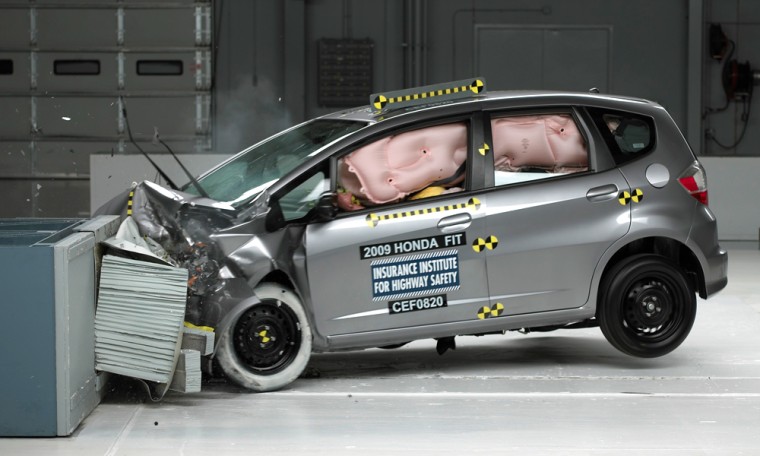“Government Crash Test Scores Plummet!”
That could be the headline next summer, when the federal government begins subjecting new car models to a battery of tougher crash tests.
The result will be lower test scores, even if the cars themselves remain the same or even have improved crash protection.
Casual shoppers who haven’t heard about the new tests could be startled when they see window stickers on 2011 models indicating the car may have only scored two or three stars in government crash tests, rather than the four or five stars that are typical now.
“Consumers have to recognize that it is not because previously five-star cars suddenly got less safe,” said Adrian Lund, president of the Insurance Institute for Highway Safety, which advocates for improved auto safety. “They are going to see the overall scores are going to be down.”
Ironically, the reason for the lower scores will be that cars have gotten so much safer.
“Ten years ago there were bad cars and there were good cars,” said Volvo spokesman Dan Johnston. “Now there is not a bad car out there” in terms of crash safety, he said.
Testing done by the National Highway Traffic Safety Administration bears that out. In 2007, for example, 98 percent of vehicles tested scored four or five stars in the frontal impact test, minimizing the value of the scores. “We’re victims of our own success,” concluded NHTSA spokesman Rae Tyson.
That doesn’t mean all new cars provide optimum protection. “There are a number of cars I would not want to be in a crash in,” said David Champion, director of the auto test department at Consumer Reports. While those cars protect well in some respects, they may still expose occupants to lower leg injuries or be vulnerable to side impacts, he said.
Five stars could become more elusive
Consumer interest made crash test scores a front-burner issue for automakers when, starting with the 1994 model year, NHTSA stopped reporting arcane injury criteria scores from crash test dummies and implemented an easy-to-understand star rating system, like a movie reviewer might use.
The frontal test was supplemented by a side impact test beginning in the 1997 model year, and for 2001 the agency added a rating of the vehicle’s likelihood of rolling over, based on its width and height. The rollover score was upgraded in 2004 with actual testing.
The arrival of an obvious safety scoring system from the government, along with televised images from tests by the Insurance Institute for Highway Safety, made safety scores a more important factor in vehicle purchase decisions. That made the scores more important to carmakers, who have heaped on all manner of air bags and heavy steel armor, far in excess of the increasingly irrelevant minimum safety requirements.
“When we first started those programs there was a wide variation from one model to the next,” said Tyson, the agency spokesman. “They have improved to the point there isn’t much differentiation."
This motivated the agency to stiffen the requirements for a good score, to help again separate the safest cars from the rest.
Among the new tests is one simulating a car sliding sideways into a tree or a pole. Side tests are much more challenging because of the relative lack of crush space to absorb the blow compared to a frontal impact, which can be absorbed by the engine compartment before it reaches the passenger cabin.
The pole test makes side impact protection even harder by concentrating the crash injury in just one small place, easily ripping through even the heavily armored sides of current models.
Additionally, NHTSA will conduct crash tests using dummies meant to replicate a small woman, forcing car makers to design seat belts, air bags and other protection devices to work effectively over a wider range of conditions than when just designing to score well with dummies the size of adult men.
The result could be that at this time next year there will be no cars that have a five-star rating, although Lund, of the Insurance Institute, believes there will be some.
Not all models will be tested right away. The agency aims to test best-sellers first, with a goal of ensuring that 85 percent of all cars sold are represented by a crash test score, according to Tyson.
Despite the challenge of the new tests, safety advocates complain that they aren’t as tough as they could be.
“Instead of going after dramatic new crash tests, they stuck with the same crash scenario,” Lund said. “They tweaked [the existing test] some.”
The IIHS, for example, performs roof crush tests to predict rollover protection, and rear-impact tests to protect rear seat occupants. Another dangerous kind of crash is one that is between a frontal impact and a sideswipe, with the impact coming into the side of the car from the front, he said.
Also it would be helpful if trucks and cars could be designed so that when they collide, the car doesn’t slide under the truck, “under riding” it and defeating the car’s crash protection systems, Lund added.
NHTSA won’t predict how many lives may be saved as automakers compete with each other for top ratings in the new, tougher crash test ratings, but observers believe there will be some.
“I think we will save lives as a result of these improvements,” predicted Lund. “But not as many as one might have hoped.”
Once automakers conquer this round of tests, the next frontier will be to preserve safety while reducing weight and improving fuel efficiency.
“There is going to be a [fuel consumption] penalty,” from meeting the new test requirements, Lund said. “It will require a little more weight and a little more fuel to achieve.”
The best way to advance safety while reducing weight would be to use continuously improving electronic systems to prevent crashes from ever occurring, said Volvo’s Johnston. “In 10 years will you even need crash tests?” he wondered.
